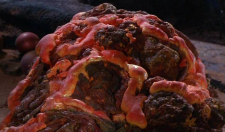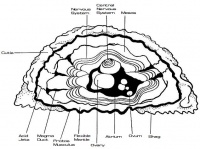More actions
| Line 55: | Line 55: | ||
The Horta are by nature a cheerful, pacifist, mostly unflappable race with rock-solid pokerfaces. [[Vulcan (Species|Vulcans]] in particular seem to have a special affinity for this intelligent, complex species, and the interest is generally mutual. | The Horta are by nature a cheerful, pacifist, mostly unflappable race with rock-solid pokerfaces. [[Vulcan (Species|Vulcans]] in particular seem to have a special affinity for this intelligent, complex species, and the interest is generally mutual. | ||
Due to their intense curiosity and high intelligence, it took no longer than a few years after the hatching of a new | Due to their intense curiosity and high intelligence, it took no longer than a few years after the hatching of a new generation in 2267 for Horta to appear on starships and elsewhere in the Federation. | ||
[[Image:Horta mother.jpg|200px|thumb|right|Horta Prime Mother near the new hatching]] | |||
The Renewal is a major element of Horta culture; the Prime Mother (also known as the All Mother) of each Renewal is a significant figure in each new generation. While the Prime Mother cares for the eggs she will often lose a significant amount of weight (attributed to the fact that Horta mothers are 'natural worriers'), appearing no taller than an adolescent by the time the young ones begin hatching. | |||
Incapable of verbal speech, Horta use a combination rumbling sounds, smells and psionic waves for communication; as well as a complex body language that involves a great deal of shuffling and wiggling movements reminiscent of 'bee dances'. | |||
To facilitate communication with humanoids Horta can be fitted with vocoders and universal translators. In a pinch, etching words onto any available surface by means of their acid has worked quite well. Some Starfleet personnel carry personalized vocoders with mechanic arms and sensor equipment to substitute their phalanges (and to no continuously have to take care to not accidentally eat another [[Tricorder|tricorder]]). | |||
Revision as of 11:26, 22 November 2015
| Species Information | |
|---|---|
| Horta | |

| |
| Quadrant: | Alpha Quadrant |
| Star System: | Janus |
| Planet: | Janus VI |
| Species Type: | silicon-based lifeform |
| Discovered By: | USS Enterprise |
| Leader(s): | Prime Mother, Janus Parliament |
| Contact: | 2267 |
| Affiliation: | UFP |
The Horta are silicon-based lifeforms native to Janus VI. They are members of the United Federation of Planets.
Physiology
The exterior of a Horta consists of a ruddy or grey-brown rocky carapace which is highly resistant to damage; anything but the highest phaser settings feels like nothing more than a mild irritation to the Horta. Young Horta have been affectionately described as a glittering pan pizza about half a meter high, however a fully grown adult Horta more resembles a rugged, rounded, glittering shape over a meter tall and two meters broad, patched in rough amethyst, tourmaline and ruby; with dark fringes all around.
The carapace is sprayed with a teflon compound when Horta go offworld, as the oxygen environment favored by a majority of Federation species tends to be corrosive after lenghty exposure.
On their underside, Horta have numerous cilia to move about, protected by a ring of fringes growing from the edges of the carapace.
They have poor eyesight, and mostly see in the Infrared spectrum. Their method of hearing involves detecting atmospheric vibrations, and they have a highly developed sense of smell that assists them in communication.
Horta are able to survive exposure to the vacuum of space, though the shock often results in a temporary 'stunned' state, and prolonged exposure may lead to coma.
They also happily eat through power conduits, quite unaffected by energies and radiation passing through them.
Nutrition
The Horta diet consists of rocks and minerals which they dissolve with a powerful acid secreted from glands at the underside of their bodies; this acid is also the means by which Horta tunnel through their rocky environment as easily as a humanoid might walk through air.
When a Horta is frightened, it may lose control of their acid glands in an instinctive urge to tunnel to safety. They can however learn to suppress this instinct, so as to for example not damage the deck plates of a Federation vessel and unceremoniously drop to the deck below.

Since Horta derive both nutrition and flavor from the metallic elements and silicates found in the rock they eat, they can tak a bite of any mineral or metal and seconds later give a readout of its constituent elements, with the expert precision of a gourmet reporting on the ingredients and balance of a wine sauce.
Spacefaring Horta find isolinear chips with an oil dip a refreshing snack, as replicated rock often lacks flavor. When possible, they like to buy rocks and minerals from other worlds, many of which are considered delicacies.
Reproduction
Horta are extremely long lived, have no natural predators and are practically indestructible; as a result, over time, Horta populations grow substantially. As a means of population control, once every 50,000 years the Horta undergo a mass self induced extinction; the Renewal.
Before each renewal the Horta lay their eggs in the Vault of Tomorrow and leave a single caretaker, the Prime Mother, to see the next generation into the world.
Between Renewals Horta reproduce as many other species, on a two gender basis (the official Fleet gender designations are "orthomale/female type B-4A, also described as "close enough for jazz").
Hatching Horta burn out of their eggs as soft, round- to ovoid creatures, roughly 40 centimeters long. They quickly develop their rocky armor and begin to eat as soon as they are born, growing to adolescent size within a matter of days.
Culture and Society
The Horta are by nature a cheerful, pacifist, mostly unflappable race with rock-solid pokerfaces. Vulcans in particular seem to have a special affinity for this intelligent, complex species, and the interest is generally mutual.
Due to their intense curiosity and high intelligence, it took no longer than a few years after the hatching of a new generation in 2267 for Horta to appear on starships and elsewhere in the Federation.

The Renewal is a major element of Horta culture; the Prime Mother (also known as the All Mother) of each Renewal is a significant figure in each new generation. While the Prime Mother cares for the eggs she will often lose a significant amount of weight (attributed to the fact that Horta mothers are 'natural worriers'), appearing no taller than an adolescent by the time the young ones begin hatching.
Incapable of verbal speech, Horta use a combination rumbling sounds, smells and psionic waves for communication; as well as a complex body language that involves a great deal of shuffling and wiggling movements reminiscent of 'bee dances'.
To facilitate communication with humanoids Horta can be fitted with vocoders and universal translators. In a pinch, etching words onto any available surface by means of their acid has worked quite well. Some Starfleet personnel carry personalized vocoders with mechanic arms and sensor equipment to substitute their phalanges (and to no continuously have to take care to not accidentally eat another tricorder).
